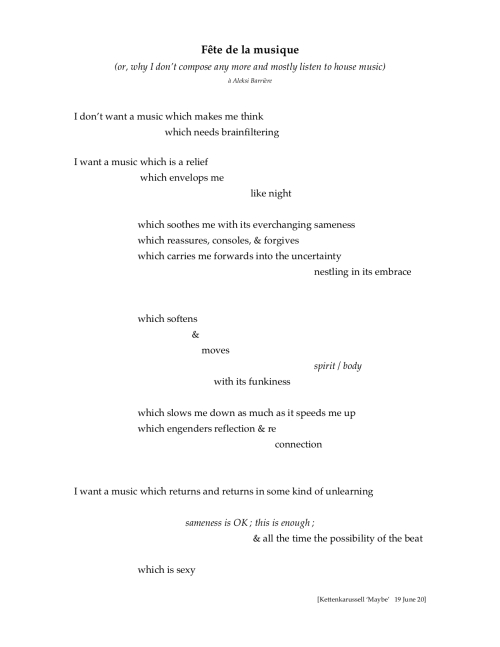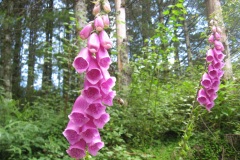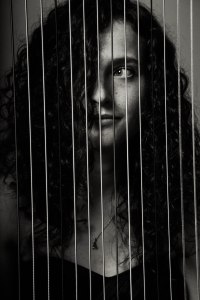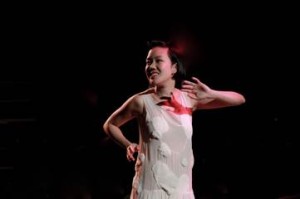
The Winter’s Tale with The Hermes Experiment
ON DEVISING A PIECE WITH FRIENDS: The Winter’s Tale devised with Nina Brazier and The Hermes Experiment
Compared with ‘normal’ composition, where one sits lonely at one’s desk for weeks or months at a time, devising a piece with other people is rather different: it is quite a bit quicker, quite a bit more unpredictable, and (if one is honest) quite a bit more fun. Luckily our visions were not too dissimilar: Nina Brazier (the director), The Hermes Experiment, the actors and I are all interested in layering text, music and movement together in a variety of ways, such that each strand is dominant or subordinate at different moments, sharing equally in the unfolding of the narrative. Sometimes we hope to excite or overwhelm; sometimes we hope that simplicity will move you. My position as ‘composer’ of the piece is precarious: while my name appears at the top of the score (a compilation of instructions, including only sparse musical notes), the music is as much by The Hermes Experiment as it is by me, since most of what you will hear is being improvised live, according to musical shapes and behaviours agreed in advance. The ‘folk song’ appearing in the second half is a case in point – particularly since it is the first tonal piece I have ‘composed’ in about 15 years! When someone suggested that a folk song would suit one scene well, the soprano Héloïse sketched out its opening melody; I then fleshed this out into a rough whole; finally Héloïse, Anne (who plays it later on the Harp) and I all tweaked it here and there until I no longer remember who was originally responsible for which note.
The Winter’s Tale will be performed at London’s Cockpit Theatre on 13th December 2016.
With many thanks to Arts Council England, RVW Trust, Hinrichsen Foundation, Britten-Pears Foundation and Aldeburgh Music for their generous support in the project’s development.
Posted in Uncategorized
Writing, re-writing, re-contextualising: dov’è aperto l’azzuro in Croatia
While it’s always very rewarding to go back over a piece written years previously and in re-writing find that problems which seemed intractable then are now more manageable, it is also very rewarding to find that, on occasion, you did an OK job the first time. Re-writing dov’è aperto l’azzuro, sketched in 2011, was one of the latter cases: the piece emerged from my pile of old sketches just as I remembered it – delicate, floating, ephemeral, brutal. Of course, I still made considerable changes: its rather spare skeleton score – an abandoned torso of an unfulfilled project – had to be reimagined primarily because of changes of instrumentation. From an impractically vast symphony orchestra, I was re-writing it for the chamber sized Secession Orchestra to play at the Novalis Festival on the island of Pag in Croatia later this month. Without the brooding weight of armies of brass and strings, I found myself looking for new ways of maintaining the piece’s energy, mainly through lots of decoration including the frequent criss-crossing of quasi-melodic arpeggiations. The way that Boulez coloured in his simple piano Notations in the later orchestrations – very often messily spilling over the original lines in the process! – was in the back of my mind, even though I was collapsing rather than expanding forces.
Rescuing things from the rubbish-heap is also rewarding, of course, if you’ve spent months writing them! Finding a new home for dov’è has been surprising and fun – the piece’s themes of islands, storms and (hopeful) imaginations of the future have meshed serendipitously with performance on Pag, especially in the context of the Novalis Festival (in its second year). The piece also seems to have reinvented itself as part of Gradiva, an opera in the (very) early stages of development with La Chambre Aux Echos. Drawing on Wilhelm Jensen’s 1902 novel, made famous by Freud, Gradiva is concerned with the new meanings that stuff dug up from the past takes on in the present. Set in Pompeii in the early C20th, our version reimagines the introverted protagonist as a C21st techno-nerd looking for satisfaction in the virtual world, while tsunamis rage in the outside world… Anyway, back to the present.
“After the storm, the clouds part above a dream-like island. You have never been there before; everything is fresh, and the dawn is filled with possibility. Time drifts past, intercut with aftershocks (or memories) of the storm’s violence. Inspired both by the beginning of Shakespeare’s Tempest and a beautiful moment in Nono’s Prometeo (‘ti grida la voce del dio / dov’è aperto l’azzuro‘), my piece is also an early fragment of Gradiva, an opera exploring storms, dreams, love, and climate change. “.
Posted in Uncategorized
Silbersee perform ‘Not always so’ at LOD muziektheater
The singers of Dutch vocal group and opera-makers Silbersee [ex-vocallab] along with viola da gamba player Pieter Vandeveire perform ‘Motet/Not Always So’ at LOD muziektheatre in Ghent. Incorporating live electronics, it’s a formal, ritualistic piece that sets text by Zen monk Shunryu Suzuki. ‘Nothing exists but momentarily in its present form and colour. One thing flows into another and cannot be grasped…’
Posted in Uncategorized
Budapest Festival Orchestra Apprentices
For the past couple of weeks I’ve been enjoying working on a rather fun piece – a trio for bassoon, trombone and double bass, commissioned by the Budapest Festival Orchestra for the three up-and-coming musicians on their apprentice scheme. The piece is called Triangulation, referring to the process of locating a central point with reference to three other fixed (and possibly far away) points, which seemed quite appropriate given the three very different instruments I’m writing for! Two movements are sketched so far – Equilateral, where the instruments share the same kinds of behaviour, and Isosceles, a Scherzo where pairs play off against the other instrument. Next up, Scalene…
Posted in Uncategorized
HERMES EXPERIMENT
I’m delighted to be working on a piece for the Hermes Experiment, a funky group consisting of the weird combination of soprano, clarinet, harp and double bass. I’m using a fantastic text by Elodie Olson-Coons filled with the joy of words and language (amongst other things). Performance at Limewharf in November 2014 alongside premieres by Giles Swayne and Jeremy Thurlow.
Posted in Uncategorized
Tonseisha update
After two sell-out performances of ‘opera’ Tonseisha at Central St Martin’s (as part of London’s Tete a Tete Festival this July), which we put on with the help of Arts council funding, we’re now planning for the next stage – a full production run in 2015. Watch this space.
Posted in Uncategorized
Ensemble Intercontemporain @ IRCAM
The fantastic new music group Ensemble Intercontemporain are to play my piece for voice and ensemble Foxglove (setting text by Elisabeth Bletsoe)  in the closing weekend of concerts at IRCAM’s Manifeste Festival. It’s been brilliant working with the ensemble and soprano Valerie Philippin, and I’m delighted that my piece has been chosen for performance, alongside pieces by Daan Janssens and Lauri Supponen.
in the closing weekend of concerts at IRCAM’s Manifeste Festival. It’s been brilliant working with the ensemble and soprano Valerie Philippin, and I’m delighted that my piece has been chosen for performance, alongside pieces by Daan Janssens and Lauri Supponen.
Posted in Uncategorized
Sound and Music/ OAE Portfolio Scheme
I’m very excited to announce that I’ll be writing a piece for the Orchestra of the Age of Enlightenment as part of Sound and Music‘s new Portfolio Scheme. Developed through a series of workshops with the OAE, playing on classical instruments, the piece – a short but dynamic string quartet – will be played as part of the OAE’s very cool Night Shift this Autumn in pubs/clubs across London. 
UPDATE: Here’s a short video we as part of the project, in which I talk about new music, composition, and drinking at concerts
Posted in Uncategorized
LSO Panufnik Young Composers Scheme
 I’m delighted to have been selected to take part in the fantastic LSO Panufnik Scheme, for which I will write a short piece for the London Symphony Orchestra, to be workshopped in Spring 2014.
I’m delighted to have been selected to take part in the fantastic LSO Panufnik Scheme, for which I will write a short piece for the London Symphony Orchestra, to be workshopped in Spring 2014.
Under the guidance of renowned composer Colin Matthews, the scheme is particularly exciting as it will allow me to develop the piece in conjunction with LSO players , as well as go to lots of LSO rehearsals and concerts, so seeing the orchestra ‘from the inside’… (It will also help me to catch up with my bassoonist sister Nina, who although much younger than me has already played with the LSO several times.)
Posted in Uncategorized


